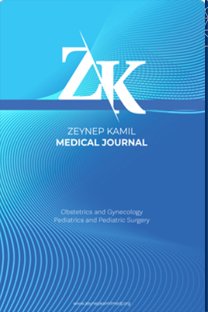An evaluation of depression levels in asthmatic children and their mothers during the course of the disease
An evaluation of depression levels in asthmatic children and their mothers during the course of the disease
___
- 1. Karaman Ö, Babayiğit A, Ölmez D. Çocukluk çağında astım. Güncel Pediatr 2006;3:56–62.
- 2. Bateman ED, Hurd SS, Barnes PJ, Bousquet J, Drazen JM, Gerald JM, et al. Global strategy for asthma management and prevention: GINA executive summary. Eur Respir J 2008;31(1):143–78.
- 3. Rosenberg SL, Miller GE, Brehm JM, Celedon JC. Stress and asthma: Novel insights on genetic, epigenetic, and immunologic mechanisms. J Allergy Clin Immunol 2014;134(5):1009–15.
- 4. Castro-Rodriguez JA, Forno E, Rodriguez-Martinez CE, Celedon JC. Risk and protective factors for childhood asthma: What is the evidence? J Allergy Clin Immunol Pract 2016;4(6):1111–22.
- 5. Ones U, Akcay A, Tamay Z, Guler N, Zencir M. Rising trend of asthma prevalence among Turkish schoolchildren (ISAAC phases I and III). Allergy 2006;61(12):1448–53.
- 6. Ekşi A, Giriş A. Ben Hasta Değilim Çocuk Sağlığı ve Hastalıklarının Psikososyal Yönü, İstanbul: Nobel Tıp Kitabevleri; 1999. p. 1–2.
- 7. Williams SA, Wagner S, Kannan H, Bolge SC. The association between asthma control and health care utilization, work productivity loss and health-related quality of life. J Occup Environ Med 2009;51(7):780–5.
- 8. Abadoğlu Ö. Asthma Control Test: Effected factors and a comparison with visual analog scale. Asthma Allergy Immunol 2008;6(1):17–21.
- 9. Lavoie KL, Bacon SL, Barone S, Cartier A, Ditto B, Labrecque M. What is worse for asthma control and quality of life depressive disorders, anxiety disorders, or both? Chest 2006;130(4):1039–47.
- 10. Demore M, Adams C, Wilson N, Hogan BM. Parenting stress, difficult child behavior, and use of routines in relation to adherence in pediatric asthma. Childrens Health Care 2005;34(1):245–6.
- 11. Ramratnam SK, Visness CM, Jaffee KF, Bloomberg GR, Kattan M, Sandel MT, et al. Relationships among maternal stress and depression, Type 2 responses, and recurrent wheezing at age 3 years in low income urban families. Am J Respir Crit Care Med 2017;195(5):674–81.
- 12. Kovacs M. The Children’s Depsession Inventory (CDI). Psychopharmacol Bulletin 1985;21(4):995–8.
- 13. Öy B. Child Depression Inventory: The Turkish reliability and validity study. Turk Psikiyatr Derg 1991;2:132–6.
- 14. Beck AT, Ward C, Mendelson M. Beck depression inventory (BDI). Arch Gen Psychiatry 1961;4:561–71.
- 15. GINA 2014 (Revision). Global Strategy for Asthma Management and Prevention; 2014. p. 11. Available from: http://www.ginasthma.org/local uploads/files/ GINA_Pocket_2015.pdfile05/01/2018tarihinde indirilmiştir (downloded date 05.01.2018).
- 16. Abadoğlu Ö. Astım kontrolünün değerlendirme anketleri. Asthma Allergy Immunol 2008;6(2):99–104.
- 17. Bilfield S, Wildman BG, Karazisa BT. Brief report: The relationship between chronic illness and identification management of psychosocial problems in pediatric primary care. J Pediatr Psychol 2006;31(8):813–7.
- 18. Fettahoğlu EÇ, Koparan C, Özatalay E, Türkkahraman D. The psychological difficulties in children and adolescents with insuline dependent diabetes mellitus. Psychiatry in Türk 2007;9(1):32–6.
- 19. Tousman S. Asthma and Depression. United States: American Academy of Allergy and Asthma Immunology, Allergy and Asthma Advocate, Winter; 2003.
- 20. Gustafsson D, Olofsson N, Andersson F, Lindberg B, Schollin J. Effect of asthma in chidhood on psycho-social problems in the family. J Psychosom Res 2002;53(6):1071–5.
- 21. Goldney RD, Ruffin R, Fisher LJ, Wilson DH. Asthma symptoms associated with depression and lower quality of life: A population survey. Med J Am 2003;178(9):437–41.
- 22. Ekşi A, Molzan J, Savaşır I, Güler N. Psychological adjustment of children with mild and moderately severe asthma. Eur Child Adolesc Psychiatry 1995;102(2):327–8.
- 23. Kannan JA, Bernstein DI, Bernstein CK, Ryan PH, Bernstein JA, Villareal MS, et al. Significant predictors of poor quality of life in older asthmatics. Ann Allergy Asthma Immunol 2015;115(3):198–204.
- 24. Janson C, Björnsson E, Hetta J, Boman G. Anxiety and depression in relation to respiratory symptoms and asthma. Am J Respir Crit Care Med 1994;149(4 Pt 1):930–4.
- 25. Oğuztürk Ö, Ekici A, Güliter S, Erdemoğlu AK, Ekici M. Bronşial astımlı hastalarda depresyon. Klin Psikiyatr 2000;3:99–101.
- 26. Ekşi, A. Pediatrinin psikososyal yönü. T. Onat (Der.), Çocuk Sağlığı ve Hastalıkları 1996;2:1075–1077.
- 27. Shimoyama S, Hirakawa O, Yahiro K, Mizumachi T, Schreiner A, Kakuma T. Health-related quality of life and caregiver burden among peritoneal dialysis patients and their family caregivers in Japan. Perit Dial Int 2003;23(Suppl2):200–5.
- 28. Rudolph M, Rosanowski F, Eysholdt U, Kummer P. Anxiety and depression in mothers of speech impaired children. Int J Pediatr Otorhinolaryngol 2003;67(12):1337–41.
- 29. Toros F, Tot S, Düzovalı Ö. Depression and anxiety levels of parents and children with chronic illness. Klin Psikiyatr 2002;5(4):240–7.
- ISSN: 1300-7971
- Yayın Aralığı: Yılda 4 Sayı
- Yayıncı: Ali Cangül
Oncologic breast surgery of retroareolar breast cancer with racquet mammoplasty technique
Hasan Hüseyin MUTLU, Elif YÜKSEL KARATOPRAK, Müferet ERGÜVEN, Nilüfer ÇETİNER
Semih BOLU, Fatih İŞLEYEN, Ayşegül DANIŞ
PET/CT dilemma in para-aortic lymph node assessment in locally advanced cervical cancer?
Tayup ŞİMŞEK, Selen DOĞAN, Özer BİRGE, Mehmet Sait BAKIR, Hasan Aykut TUNCER, Ceyda KARADAĞ
Ebru ÇÖĞENDEZ, Önder TOSUN, Mahmut ERDEMOĞLU
Bilateral serous macular detachment as a complication of preeclampsia: A case report
Özkan KOCAMIŞ, Emine TEMEL, Kemal ÖRNEK, Nazife Aşıkgarip
Evaluation of the relationship between method of delivery and breastfeeding characteristics
Selcuk UZUNER, Feyza USTABAŞ KAHRAMAN, Beyza MAŞLAK
Acute dystonia after domperidone use: A rare and an unexpected side effect
